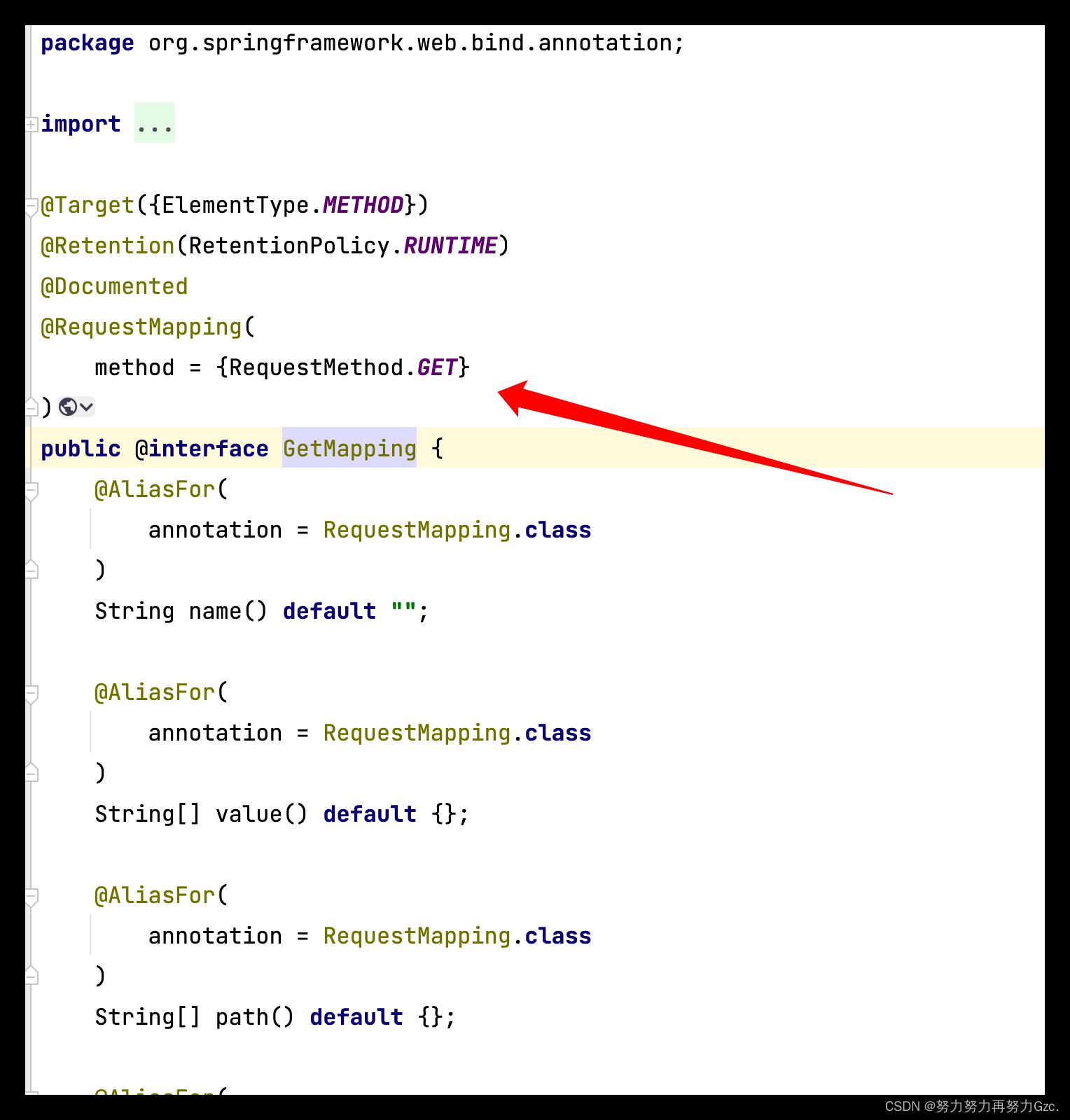详细介绍@GetMapping和@PostMapping的区别
Posted 努力努力再努力c.
tags:
篇首语:本文由小常识网(cha138.com)小编为大家整理,主要介绍了详细介绍@GetMapping和@PostMapping的区别相关的知识,希望对你有一定的参考价值。
一、前言
想要了解 @GetMapping 和 @PostMapping 的区别,首先需要了解一下@RequestMapping注解。
了解@RequestMapping注解请点我
二、@GetMapping和@PostMapping的区别
(1)@GetMapping是@RequestMapping(method = RequestMethod.GET)缩写的组合注解,用于将 HTTP 的get 请求映射到特定处理程序的方法注解。
(2)@PostMapping是@RequestMapping(method = RequestMethod.POST)缩写的组合注解,用于将 HTTP 的post 请求映射到特定处理程序的方法注解。
(3)下面来看一看@GetMapping的源码

上图中最为重要的是这行代码:
@RequestMapping( method = RequestMethod.GET )
这行代码即说明@GetMapping就是@RequestMapping附加了get请求方法。也就是说@GetMapping就是一个只能用来处理http的get请求的注解,比较专一,只能干这一件事,不像@RequestMapping可以处理多种http的请求.
同时,可以看到@GetMapping这个注解 是spring4.3版本引入,同时引入的还有@PostMapping、@PutMapping、@DeleteMapping和@PatchMapping,一共5个注解。
(4)在一般情况下我们开发可能都是用@RequestMapping(method=RequestMethod.×××),因为@RequestMapping可以直接替代以上两个注解,但是以上两个注解并不能替代@RequestMapping。
类似的组合注解还有上面提到的:@PutMapping、@DeleteMapping、@PatchMapping三个注解。
三、总结
总结一下:@PostMapping、@GetMapping、@PutMapping、@DeleteMapping、@PatchMapping都可以用@RequestMapping代替,如果怕在映射的时候出错,可以统一使用@RequestMapping(method=RequestMethod.×××),当然这样写的话也有弊端,笼统的全用@RequestMapping, 不便于其他人对代码的阅读和理解!还是建议区分开来写,养成良好的代码习惯!
SpringBoot 中常用注解@PathVaribale/@RequestParam/@GetMapping介绍
本篇博文将介绍几种如何处理url中的参数的注解@PathVaribale/@RequestParam/@GetMapping。
其中,各注解的作用为:
@PathVaribale 获取url中的数据
@RequestParam 获取请求参数的值
@GetMapping 组合注解,是@RequestMapping(method = RequestMethod.GET)的缩写
@PathVaribale 获取url中的数据
看一个例子,如果我们需要获取Url=localhost:8080/hello/id中的id值,实现代码如下:
@RestController
public class HelloController {
@RequestMapping(value="/hello/{id}",method= RequestMethod.GET)
public String sayHello(@PathVariable("id") Integer id){
return "id:"+id;
}
}
同样,如果我们需要在url有多个参数需要获取,则如下代码所示来做就可以了。
@RestController
public class HelloController {
@RequestMapping(value="/hello/{id}/{name}",method= RequestMethod.GET)
public String sayHello(@PathVariable("id") Integer id,@PathVariable("name") String name){
return "id:"+id+" name:"+name;
}
}
以上,通过@PathVariable注解来获取URL中的参数时的前提条件是我们知道url的格式时怎么样的。
只有知道url的格式,我们才能在指定的方法上通过相同的格式获取相应位置的参数值。
一般情况下,url的格式为:localhost:8080/hello?id=98,这种情况下该如何来获取其id值呢,这就需要借助于@RequestParam来完成了
@RequestParam 获取请求参数的值
直接看一个例子,如下
@RestController
public class HelloController {
@RequestMapping(value="/hello",method= RequestMethod.GET)
public String sayHello(@RequestParam("id") Integer id){
return "id:"+id;
}
}
在浏览器中输入地址:localhost:8080/hello?id=1000,可以看到如下的结果:
当我们在浏览器中输入地址:localhost:8080/hello?id ,即不输入id的具体值,此时返回的结果为null。具体测试结果如下:
但是,当我们在浏览器中输入地址:localhost:8080/hello ,即不输入id参数,则会报如下错误:
@RequestParam注解给我们提供了这种解决方案,即允许用户不输入id时,使用默认值,具体代码如下:
@RestController
public class HelloController {
@RequestMapping(value="/hello",method= RequestMethod.GET)
//required=false 表示url中可以不穿入id参数,此时就使用默认参数
public String sayHello(@RequestParam(value="id",required = false,defaultValue = "1") Integer id){
return "id:"+id;
}
}
测试结果如下;
如果在url中有多个参数,即类似于localhost:8080/hello?id=98&&name=wojiushimogui这样的url,同样可以这样来处理。具体代码如下:
/**
* Created by wuranghao on 2017/4/7.
*/
@RestController
public class HelloController {
@RequestMapping(value="/hello",method= RequestMethod.GET)
public String sayHello(@RequestParam("id") Integer id,@RequestParam("name") String name){
return "id:"+id+ " name:"+name;
}
}
在浏览器中的测试结果如下:
@GetMapping 组合注解
@GetMapping是一个组合注解,是@RequestMapping(method = RequestMethod.GET)的缩写。该注解将HTTP Get 映射到 特定的处理方法上。
即可以使用@GetMapping(value = “/hello”)来代替@RequestMapping(value=”/hello”,method= RequestMethod.GET)。即可以让我们精简代码。
例子
@RestController
public class HelloController {
//@RequestMapping(value="/hello",method= RequestMethod.GET)
@GetMapping(value = "/hello")
//required=false 表示url中可以不穿入id参数,此时就使用默认参数
public String sayHello(@RequestParam(value="id",required = false,defaultValue = "1") Integer id){
return "id:"+id;
}
}
小结
本篇博文介绍了几种常用获取url中的参数哈,比较简单。
以上是关于详细介绍@GetMapping和@PostMapping的区别的主要内容,如果未能解决你的问题,请参考以下文章